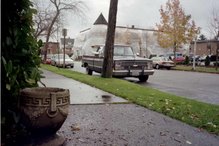The beginning of autumn, 1964, saw the public release of the Warren Report on the Kennedy Assassination. Part of this report discussed images made at the scene. In November would be the first anniversary of the Assassination. As a beginning high school student I thought of this part of the time. In a class we studied the Kennedy inaugural address.
Associated with the Hamlet ticket I have from 1964 was my assumption: by “live” I thought they meant the play would be presented on live television the way the new year’s eve ball dropped on live television each year for us, in Tacoma, at nine in the evening. I misunderstood. Hamlet was performed live at a theater and recorded on video cameras.
The idea
that an original work of art, extracted from experience or pure imagination by
an artist, differs from some replica or some adaptation occurred in the 2013
movie, Saving Mr. Banks, about the author of Mary Poppins. Mrs. Travers flew to
Los Angeles from England in 1961 and tried to prevent Walt Disney from using
her character in a typical Disney movie.
Walt Disney, who put her up in a plush Beverly Hills hotel room filled
with plush Disney animals, got his way, she did not. She did not like the movie, Mary Poppins,
when she attended the opening in 1964. However
the movie and the money encouraged her to write more stories. The end credits show
across a reel-to-reel tape recorder, the sound of her voice and the Disney
worker voices are surely a digitally recreation of the tape.
2. The Amazing Theaters
Electronovision
and Hamlet in 1964 was a product for American theaters to offer. If it had caught people’s interest, it might
have meant economic opportunity for old iconic American theaters. Electronovision also did 1964 rock
production. Regarding opportunity for
theater owners:
“Record
dealers in cities where the T.A.M.I show will be screened should experience
record sales by the dozen artists highlighting the film. Many excellent tie-ins
should be advantageous as well between the dealers and the theater owners. Both
could stand to gain. The only showings to be made, except the premiere, will be
during the holidays, December 19 through January 3, 1965.”
Iconic American
theaters, along with churches and Masonic-type lodges did face competition with
music concert performance because the quality of large amplifiers was on the
increase. Good sound could also be found
on stereo record players. Entertainment
could also be found on televisions. However
I think competition was not the only difficulty. Earlier post-war experience was a boom
economy, in which people had money to spend; people compared that time with the
way the growing urban population spent money in the early 1960s. The excellent possible advantage may have
been reminiscent of other times.
I saw Mary
Poppins and liked it. A scene late in Saving
Mr. Banks recreates the festive opening at an amazing Los Angeles movie
palace. A part of the internet search I
have done about Hamlet included looking up a few of the theaters listed in the
New York Times with their Hamlet ad.
About fifty-six theaters in New York are and New Jersey showed the
film. Some of these theaters exist
today, restored and showing movies. Some
have been demolished. Some are now churches,
some are beautiful Community Live Theaters.
It has been very lovely to view some of these iconic special places on
the internet screen, and some have interesting stories. From the internet, About The Oritani Theater, in Hackensack, NewJersey, listed as showing Hamlet: “Erected in 1926, the Oritani — named for
Oritam, chief of the Achkinheskcy Indian tribe in the 17th century — quickly
became a local landmark…”


No comments:
Post a Comment